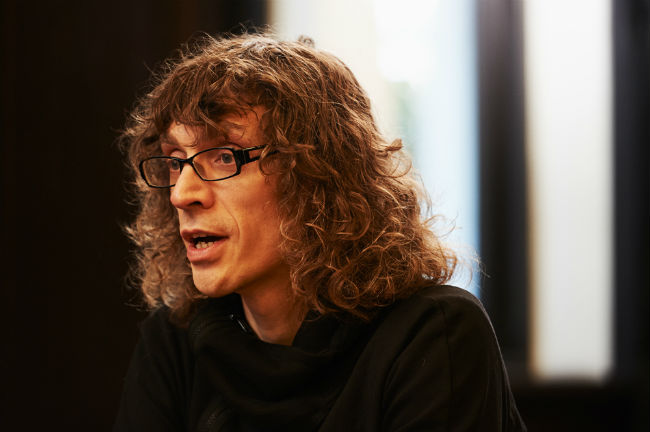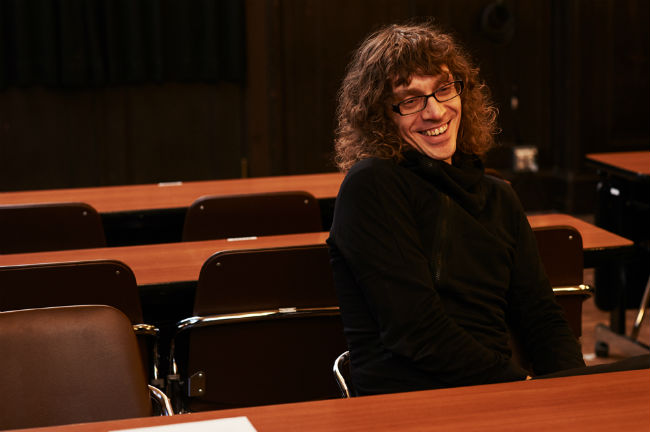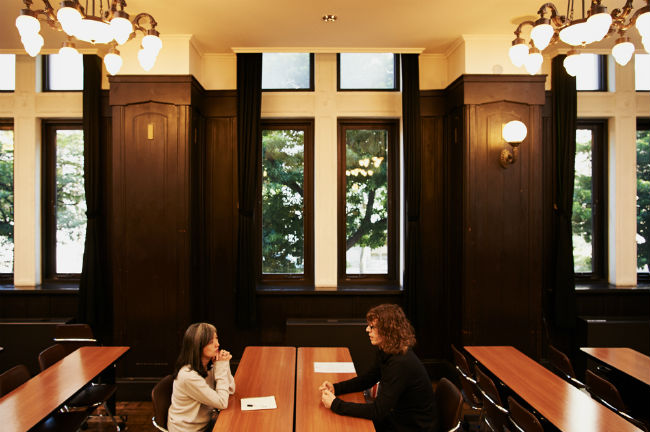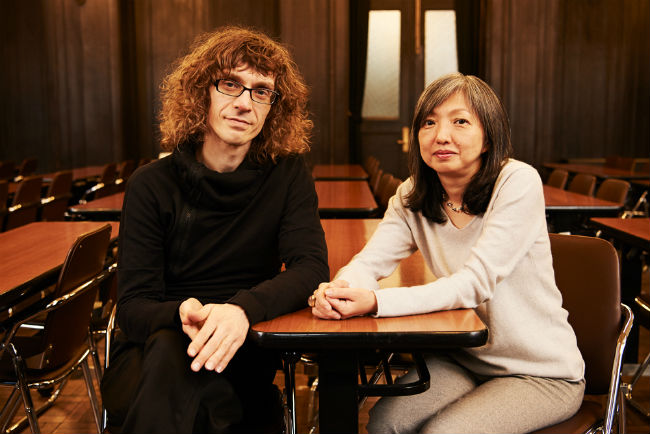The Position of Music
Yamaguchi: Can you tell me more about music as an element of your work?
Arco: Music is a very important parameter in the negotiation processes inside Abstract Dramaturgies. It structures and modulates time for the performer to negotiate with. Music is not just an accompaniment to the dance. It is a structural and expressive element of the dramaturgy, just like another performer. Music has its own trajectory and energetic landscape that interacts with the trajectory and energetic landscape of each performer.
Music can be structurally challenging or its intensity can be overpowering. It can be a constricting force for the performer to negotiate with. In some cases the music is a framework of intricate rhythms and counts where the performer is learning musical structures like a text that can last for twenty minutes or even an hour, until counting becomes like a meditation. It is important to keep the negotiation alive, and when a performance is touring a lot and the performer gets used to the counts and rhythms, we change the structures so that the negotiation process stays alive.

Arco: It is like walking through a city; Yokohama for example. Since I arrived a couple of days ago I have used a map and memorized the directions and trajectories that I need to make during the festival. More and more, I get to know the city, I know which way to go; I don't need to use the map anymore. I can start to improvise new ways to get to a place. Perhaps I will get lost; perhaps I discover a detour or shortcut. I encounter different buildings, shops, people, and so on in different ways through the city. Personally, I like to get lost in a city that I don't know, but the structure of the city still exists, and I can focus on the endless forms and details and actions that I encounter on the way every moment.
Abstract Dramaturgy provides a map of the performance made of time, space, and architectural structures that the performers negotiate with. The better we know the map, the more freedom and leisure we have to discover new elements and possibilities inside of the map. We have to be creative with the map in order to remain curious and spontaneous and not to fall into taking routine trajectories. The music is a very important element of this map.
Yamaguchi: Does music remain the same?
Arco: No. During the rehearsal process the musician is present most of the time. He improvises and changes every day. We might convene about certain durations or rhythmical structures to improvise with, but the same rhythmical structure can sound completely different every day. Most of the time the music is electronic and radical changes are possible in a short time. Very late in the rehearsal process, the music is fixed. Sometimes it's also improvised in the performance but most of the time we write the music and it exists as part of the performance map.
Yamaguchi: You have quite an analytical and structured way of working. Isn't it sometimes difficult for dancers to keep up?
Arco: Now we are talking. But the work itself is very practical. Structures are just the surface of the work. They are a working tool and not the finality of the work. It is important that the dancer understands this. And indeed for some dancers it's very difficult to count and to dance at the same time. In traditional forms the music generally follows the dancer live. But these challenges can be part of the negotiation process of a performance. Artificial time structures like a digital music composition are a tool for the negotiation process, they temporarily might make the dancer feel un-free, only to allow a process where the experience of freedom is explored and investigated from different angles. These structures are not more real than this.
Desire for Freedom
Yamaguchi: By the way I saw your work Hanoi Stardust in Brugge, Belgium. It was a work with dancers from Vietnam and the third part with classical ballet dancers was very interesting. They are all well-trained, classical ballet young female dancers, they make very precise and elegant forms, after some time it begins to slightly change and go in another direction, which was quite exciting. How was the process of creating this piece?

Arco: All the processes that we are discussing here are time intensive. It is important not to rush. In the current performing arts economy it is challenging to have enough time. This is particularly important for collaborative and transcultural work. Hanoi Stardust was made with dancers of the Vietnam National Opera Ballet (VNOB). With institutional companies, it is particularly difficult to have enough time for the process. These companies are used to working very fast and are product-oriented.
We nevertheless managed to have two months and a bit with the dancers in rehearsal. We spent most of this time improvising, discussing, and elaborating on the negotiation processes of the vocabulary of elementary classical ballet starting from breathing. We did not hold on to any results and, only very late in the process, a map was defined for the negotiations to take place. It was very challenging for these dancers to work very hard every day and not to keep any fixed results that could be reproduced. Then the definition of the map, time, space, and architecture was a pivoting moment. A true understanding of the nature of the negotiation process grew with each of the performers. The process gave completely new contours to their freedom and creativity as performers and personalities.
Hanoi Stardust is about personal freedom within the given forms of classical ballet. Freedom is an elementary human idea, and the desire for freedom is an elementary human experience. It is a simple yet vast theme to work with, no matter what cultural background we have. Practically, the idea of freedom only exists if there is its opposite, hence the negotiation process with constricting structural elements.
As mentioned before, time, space, and body-architecture are the constricting structural elements of the performance map. They are non-narrative parameters but they have metaphorical value that a performer, as well as a spectator, is free to read in personal ways. We all are confronted every day with conditions that define, influence, or constrict our freedom, at home with the family, at work, in the subway, in the car, in a traffic jam; everywhere, all the time no matter in which country or culture. Feeling free or un-free is a dilemma everybody experiences at some point in many different forms and contexts. The work with these physical parameters allows experiencing and investigating this feeling in a non-narrative way.
Yamaguchi: It is also fascinating to listen to your structured explanation about your working process. How did you get this clear language?
Arco: Everything we talk about here stems from practice. As I try to convey the experiences through words, it might sound analytical and clear, but in reality there is a lot of trial and error, a lot of experimenting, learning from mistakes, and building on insights step by step. In the beginning of a process I don't have a masterplan or a precisely defined goal. It is a process from day to day. Hanoi Stardust began with such a white page; the first day of rehearsals there was no plan what to do. But we are there and something will come up.
Working as a Dramaturge
Yamaguchi: You are a choreographer but work also as a dance dramaturge together with artists like Eko Supriyanto in the piece Cry Jailolo and Balabala. What exactly was your role in these collaborations?
Arco: I like to support people with special talent in developing their artistic trajectory, like Eko Supriyanto that you mention. This activity has been coined dramaturgy, later I have changed the name to "creative presence" because of the unpredictable, unsystematic, and miscellaneous nature of that activity.
Yamaguchi: What was your contribution in making Cry Jailolo?
Arco: I met Eko in 2010. I invited him to join Monsoon, a platform for transcultural exchange and collaboration between Asian and European artists that took place in Leuven, Belgium that year. In 2012 we made solid.states together. The performance we talked about earlier. The choreographic processes that were developed during solid.states have been very influential for Eko's following works as a choreographer.
When Eko approached me with the starting point of Cry Jailolo, the common ground was obvious and I decided to support the development of the project. The first working phase together was to develop a twenty-minute version of the performance into a one-hour version. That was foremost a dramaturgical task and perhaps that is why my contribution was coined "dramaturgy."
During discussions and rehearsals we investigated the existing structures and movement vocabulary in order to deepen it and to extend these seeds that Eko had already created. It was an ongoing dialogue during Eko's rehearsals with him and with the boys, in Jailolo when possible, and on distance otherwise.
Monsoon Platform
Yamaguchi: Can you tell me about Monsoon platform which you initiated?
Arco: Monsoon is an ongoing series of transcultural, multidisciplinary, and collaborative research platforms for Asian and European artists. The general idea is to provide artists with quality time and space to encounter and to do what they want. There have been eight Monsoon platforms so far, in Europe, Asia, and Australia.
Each platform proposes different strategies and provides different conditions depending on who is hosting the platform, available budgets and so on. Monsoon is an intentionally small-scale platform, self-organized as much as possible by the invited artists. All artists are participating on invitation. There is no open-call or application. Monsoon is a moment of suspending difference through strategies of encountering, being and doing together in an artistic and intimately cosmopolitan context.
This year, 2017, there are three Monsoon platforms: one in Antwerp hosted by wp Zimmer, and two during the EUROPALIA Indonesia Arts Festival, hosted by STUK in Leuven and Vooruit in Ghent.
Yamaguchi: What is EUROPALIA Festival?
Arco: EUROPALIA is a large biennial arts festival based in Belgium. Since about forty-five years ago, it takes place every two years with a different guest country. The guest country in 2017 is Indonesia, and I was invited to curate the performing arts program. Exchange projects, collaborations, and new commissions are at the core of the program. The Monsoon platforms were two of these exchange and collaboration projects, and we commissioned five new dance creations.
Yamaguchi: May I ask whom you have commissioned?
Arco: Darlane Litaay from Papua with Morning Star Dark Valley, and Otniel Tasman from Banyumas with NOSHEHEORIT, Eko Supriyanto makes a solo SALT that he is performing himself. Melati Suryodarmo creates a group work Tomorrow As Purposed, and Meg Stuart will soon premiere Celestial Sorrows.

Yamaguchi: How does Monsoon function?
Arco: Every Monsoon platform is different. The starting point of the most recent two platforms during EUROPALIA is artistic blind dates between Indonesian and European artists. The participants don't know beforehand who is going to be the other person. No preliminary research, hence no judgment before the actual meeting is possible. The spirit of this setting is intimate and cosmopolitan at the same time. And the four blind dates are, of course, free to also develop as a group of eight or less.
The duration of the platform is short—five days, seven days, or sometimes ten days. Artists are free to work the way they want. Monsoon proposes lunch and dinner together, and these are often most animated and creative moments of group interaction.
Monsoon also proposes a selection of local events or activities that the artists can engage in or not, depending on the schedule they devise for themselves.
Zap-guests appear at specific moments for a lecture, an activity or a meeting to introduce special knowledge not necessarily artistic. We invited, for example, an investment banker, a biochemist, a professional athlete, a video game developer. Artists are given the freedom to engage with these impulses or not. These are some elements that constitute the Monsoon platform, but again, every platform is different and there is no fixed formula.
Future Plan
Yamaguchi: You created your solo show EAST at the Asian Arts Theatre in Gwangju in 2016 under the curation of Helly Minarti. How was it?
Arco: The festival curated by Helly Minarti was called Gaze Project Myth. The starting point of EAST was on the one hand to experiment with the processes developed together with performers in Southeast Asia and myself as a performer. Frequencies of vibration through the body turned out as a choreographic language. On the other hand, EAST started as a research project about Ruth Saint Denis' orientalist choreographies and their role in the development of modern dance in the United States and Europe.
Yamaguchi: What are your next projects?
Arco: I am taking time off without new creations in between 2017 and 2018. Contemporary dance is becoming an economy dominated by institutional agendas and managerial practices. I need to reflect on this development. And I am taking time to study and to teach. It has been my wish for several years to take some time off the production cycles, and this moment has now arrived.
Besides curating for the EUROPALIA Indonesia festival, I am working on a publication about my work in Europe and Southeast Asia during the past fifteen years. It is a poetic experiment to translate choreographic, transcultural collaboration processes into a different media. I am also developing a performance-lecture connected to this publication. There are other projects at the horizon, but it is too early to talk about them now.
About Collaboration
Yamaguchi: There are young artists in Japan who are creating quite precise works. Not many of them are interested in going out and doing international collaboration.
Arco: Making art is always collaborative. We don't do anything alone, especially not in the performing arts. Making art is about encoding experiences and relationships into artistic language. These relationships can be between people, people from different cultures, an artist and a book or a film or other data. Relationships are incessant and endless.
Art tells us something about the world we are producing. If you say that Japanese artists are not interested in collaborative work, then this means something. Is it a problem? I don't know. Perhaps we are looking at a social phenomenon here that is more complex.
Interdisciplinary and intercultural collaboration is currently quite a fashionable idea. However, the motivation has to be human and artistic; there needs to be curiosity, generosity, and a healthy dose of aimlessness while being perseverant and very determined. Personal, institutional, or governmental agendas cannot replace these fundamental starting points. I wish, however, that they could recognize and support them as values. The balance of give-and-take is not easy to strike in transcultural collaborative work.
Yamaguchi: So far collaboration is good for you?
Arco: I do art in a transcultural collaborative context in order to exit myself; to exit the utilitarian path of least resistance and routine. It is an ongoing process of de-subjectification that confronts with the diversity and richness of the world. In my experience, artistic transcultural collaborations are processes of suspending difference and affirming a shared movement of creativity, curiosity, and respect. As such, in today's context, transcultural collaboration is also an act of resistance. And if you like it, you can dance it.
Yamaguchi: Thank you very much for sharing your concept and thoughts about dance and your creative process.

[On February 19, 2017 at the Yokohama Port Opening Memorial Hall]
More on the Individuals/Groups Mentioned
Kobalt Works Official Website
Eko Supriyanto (EKOSDANCE COMPANY Official Website)
Rithisal Kang (Amrita Performing Arts Official Website)
Olé Khamchanla (KHAM Company Official Website)
Interviewer: Makiko Yamaguchi
After working on cultural exchange between Japan and Germany through music, theater, dance, and photography in the Cultural Department at the Goethe-Institut Tokyo, she managed performing arts exchanges, the promotion of Japanese culture, and information exchanges at the Japanese Culture Institute in Cologne (The Japan Foundation). From spring 2011, as Director at the Tokyo Culture Creation Project Office of the Tokyo Metropolitan Foundation for History and Culture, she was in charge of the networking program. Since 2015 she is working at the Japan Foundation Asia Center for exchange and collaboration in the field of contemporary performing arts between Southeast Asia and Japan.
Photo: Jouji Suzuki






